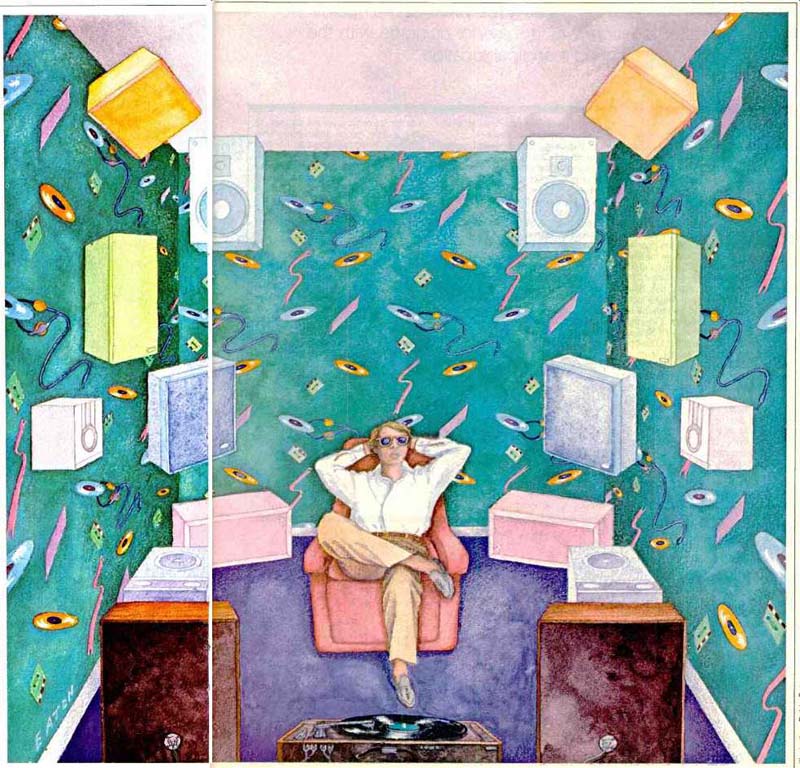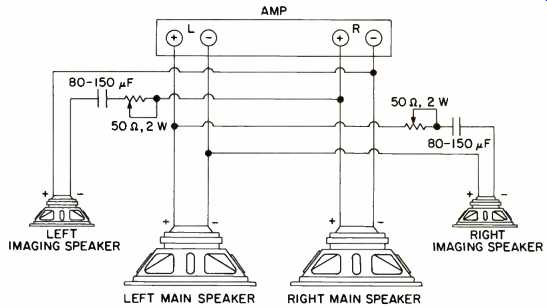
by Richard J. Kaufman
There are several classes of accessory systems on the market whose purpose is to improve the spatial quality of stereo sound reproduction. Quadraphonic sound, in all its many splendored varieties, was one of the first, and it still has its adherents. The "ambience recovery" or "ambience generation" systems are another major group. These use digital or analog delay lines to feed a delayed version of the left and right channels through one or more auxiliary speakers behind the listener. The intent is to superimpose the acoustic qualities of the recording space on the listening environment so that a small den can sound like a large hall.
Now there is another class, the image enhancement or image recovery device. Bob Carver, the first practitioner of this art, dubbed his system Sonic Holography; soon after, Joel Cohen of Sound Concepts introduced his Image Restoration system. To my ears, image enhancers are among the most successful and satisfying accessories available.
To understand how Carver's Sonic Holography works, consider what happens when listening to a stereo system: A signal leaves the left speaker and, travelling at the speed of sound, reaches the listener's left ear. A portion of the signal's wavefront is diffracted around the listener's head and, travelling an additional 5 or 6 inches, reaches the right ear about 100 microseconds after reaching the left ear. This "interaural" time difference is one of the brain's major clues to the spatial location of sounds.
With uncanny accuracy, the human brain pinpoints the location of the speaker, which may not coincide with an accurate representation of the sound's original location. Listen to your system. You'll find you're always aware of the location of the speakers, even with your eyes closed.
Sonic Holography works to change that perception. This "black box" sends the left-channel signal through a delay line, inverts it, and mixes it with the right-channel signal. When the left-channel signal is diffracted around the listener's head, it reaches the right ear at precisely the same time as the electronically delayed and inverted signal that was fed to the right channel. The signals cancel, the right ear hears nothing, and the signal seems to be coming from the listener's extreme left instead of from the speaker. (The right channel is treated similarly.) There are complications. For the effect to be convincing, the delayed signal must be attenuated slightly, and the bass filtered out. Bass is non-directional in its propagation, and to include it in the processing would result in an unwanted bass boost. The highs should be excluded too, or the sound could be excessively bright, since shorter wave lengths aren't diffracted and so don't need to be cancelled.
When properly set up--and setting up is a little tricky--the effect of Sonic Holography can be quite startling. If the unit is switched off while listening, the sound field seems to collapse into the plane of the speakers, and the instruments sound as if they're lined up on a string in between.
With the unit on, the sound becomes three-dimensional, at once pleasingly convincing and spatially textured.
Sounds appear in front of or behind one another, and even beside the listener. Of course, the listening area is more proscribed than for stereo; one must be equidistant from the speakers and the proper distance away from them.
You might expect earphones to give the same three-dimensionality, but they don't. Psychoacoustic research has shown that tiny, almost imperceptible head movements are used by the brain to focus a sound's location or direction. When you move your head, earphones move with you, foiling the brain's sound location system. The only logical location for a sound that moves with your head is inside it. Headphones just are not spatially convincing for most people.
In the image enhancement system from Sound Concepts, only the difference signal between channels is delayed and crossfed to the respective speakers. It is claimed that by operating on right-only and left-only information instead of on the entire signal, comb filtering is eliminated, resulting in a smoother frequency response.
I've heard both systems but have not had a chance to compare them directly. Both sound good, and are a distinct improvement over ordinary stereo.
It is possible to achieve somewhat the same results as do these electronic boxes, by passive means. If you enjoy experimenting, or want to try out the effect before investing in the electronics, this project is for you.
If any Audio reader wishes to produce the device described in this article, Bob Carver grants to such a reader a royalty-free license for the apparatus as covered by his U.S. Patent 4,218,585. Such license is for personal use only and does not extend to commercial use or to manufacture for sale.
Basically, two speakers are wired to invert the signal, and positioned at the proper distance to provide the required cancellation. Figure 1 illustrates the hookup. Potentiometers or L-pads are used to attenuate the imaging signals, for the extra speakers are likely to play a little louder than your main speakers. Fixed resistors can be substituted if they provide the proper attenuation. A capacitor is included for bass attenuation, and may be omitted if the extra speakers do not reproduce the bass below 100 Hz or higher. I would recommend using capacitors in any case, for by blocking high-power bass signals, they increase the auxiliary speakers' power handling ability.
How image restoration works sonically is shown in Fig. 2. In addition to the direct L and R signals heard by each ear, the delayed signals R' and L' are also heard, attenuated by factor alpha. Each ear hears both speakers with image recovery, but the delayed signals alpha_R' and alpha_L' are cancelled by an inverted crossfed signal. Note that though a delayed cancellation signal reaches each ear (- alpha_2L" and - alpha_2R"), these signals are attenuated by the square of a and so have little perceptual effect. The left ear hears a pure L signal, while the right ear hears a pure R signal.

Fig. 1--This passive image recovery system consists of two extra speakers
connected to play an inverted crossfed signal. Capacitors are 50 V, non-polar.

Fig. 2--In a normal speaker setup, each ear hears both speakers (A), while
in the image recovery system, the left ear hears only the left speaker and
the right ear only the right (B). See text.
Finding suitable speakers should be easy. Anything with a reasonably smooth frequency response can work well, though an 8-ohm impedance is desirable. Nor is it necessary to cover the full audio spectrum. In fact, a somewhat limited frequency response is an advantage. I am using a pair of midrange speakers from my junk box.
They go from about 250 to 5,000 Hz; 300 to 3,000 Hz is the minimum range to aim for, and it may be possible to get good results with an even narrower range. Even 3- to 5-inch automobile speakers should be suitable when properly mounted. (One nationwide electronics chain carries a number of speaker systems in the $10 to $25 price range that look like they'll work well.) Note that overall system impedance should not be less than 4 ohms, or some amps will have trouble driving the load. And note, too, that there is a difference in most cases between the maker's stated impedance and the speaker's real impedance.
If the highs prove too bright, disconnect the tweeters in the auxiliary speaker systems or angle the speakers away from the listening area. Another solution is to cover the speaker with a layer of tightly woven fabric.
Positioning the extra speakers will be critical. Ideally, the signal path should be 5 or 6 inches longer to the imaging speakers. I have my speakers mounted on stands, with the imaging speakers underneath and on the floor, slightly behind the front plane of the main units' cabinets. They could as well go beside or on top.
One method I've found useful for positioning the imaging speakers is this:
Play only the left channel, either by disconnecting the right channel or adjusting the balance control. Vary the position and sound level of the right imaging speaker until the sound seems to be coming from the extreme left (or as much to the left as possible) when you are in your chosen listening position. Repeat for the right channel.
You may find that moving your main speakers closer together will enhance the effect.
Your listening location is more flexible for the passive system than for electronic imagers. It is possible to arrange the speakers so that the listening position is not on the center line between the main speakers.
Too many reflective surfaces will diminish the imaging effect. If your listening room is too live, you may want to add draperies, rugs and perhaps paintings. This will also improve the acoustics for ordinary stereo.
A complication may arise with many speaker systems that don't use minimum-phase (i.e. linear-phase or Time-Aligned®) crossover networks. The proper location for the auxiliary speakers will be different at different frequencies. It may not be possible to obtain a stable image with such speakers using a passive imager. In any case, experiment with speaker location for the best effect. Less-than-perfect may prove acceptable. (Most speaker systems have sufficiently accurate phase response to work with a passive system.) If the imaging speakers are connected to the auxiliary speaker outputs of your amp or receiver, the imaging effect can be switched in and out. Every one I've played it for prefers the sound with the imaging speakers in. Hearing them switched off invokes an eerie sensation of space collapsing, as if the instruments were suddenly sucked into the speakers.
There is a striking similarity between this setup and some of the early passive devices used to simulate quadraphonic sound. As I recall, an admonition with these units was that speaker positioning was critical. Could it be that the proper position was one that produced the same signal cancellation as does image recovery? And that the rush to discrete four-channel sound completely missed the point? Of course, this is speculation, but psychoacousticians have shown that a dummy head equipped with microphones for ears, when made to follow exactly the head movements of a listener wearing headphones, gives a convincing representation of sonic space. Image enhancement systems are the closest we can now come to matching this experimental condition with recorded media. Only listening will allow each reader to judge the merits of image enhancement systems. The passive image enhancement system will allow many more people to listen and. I believe, enjoy.
Because L-pads waste power and the required potentiometers are not readily found, I have arranged to make a set of potentiometers and capacitors available for $12.00 while the supply lasts. This cost includes shipping and handling in the U.S. and Canada; New York residents, please include local sales tax, and foreign orders should include an additional $3 for shipping.
Please allow six to eight weeks for delivery. If you are interested, send a check or money order to: RK Systems, Box 10-E, 780 West End Ave., New York, N.Y. 10025.
(Source: Audio magazine, May 1983)
Also see:
A History of Binaural Sound (Mar. 1986)
= = = =